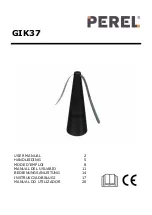
GUITAR RIG SESSION – 25
4.4.3 The Input Level of GUITAR RIG 4
It is assumed that your guitar is connected to the SESSION I/O and its input level is properly
adjusted (see section
4.4.1
). Now we need to make sure that the input signal is processed
at the right level by the software.
Please take a look at the header of the GUITAR RIG 4 window: It consists of the input mod-
ule with channel selectors (L/R), a basic noise gate, the output module with a limiter and
information about the processing power consumed.
%
For a detailed description and explanation of the Noise Reduction circuit, please consult
the GUITAR RIG 4 Application Reference included on the product CD.
Note that the Input Meter shows an amplitude when you play. It also features an integrated
volume fader that controls the input level of the software. Please adjust it to achieve the
highest possible level for your signal without clipping. This is indicated by the Level Meter
getting close to the red zone without actually hitting it.
If only one guitar is connected, GUITAR RIG 4 will receive a mono signal. You can set up the
Input module to route your guitar signal to both channels. Per default, GUITAR RIG 4 is set
to process both input channels (L + R are activated), so one of the input channels remains
mute. To change this, deactivate the channel you are not using: Click on the appropriate but-
ton (L or R) on the left hand side of the Input Meter once, so that only the input channel in
use is active. This will route the mono signal to both channels.
4.4.4 Connecting the Output
The SESSION I/O provides two mono outputs (L/R) to connect your monitoring system, be
it a mixing desk, a pair of active speakers or your home stereo. Mind that both of them have
to be connected for stereo sound. A separate stereo output (TRS) allows for connecting your
headphones.
Содержание Guitar Rig Session
Страница 1: ...HARDWARE REFERENCE...















































